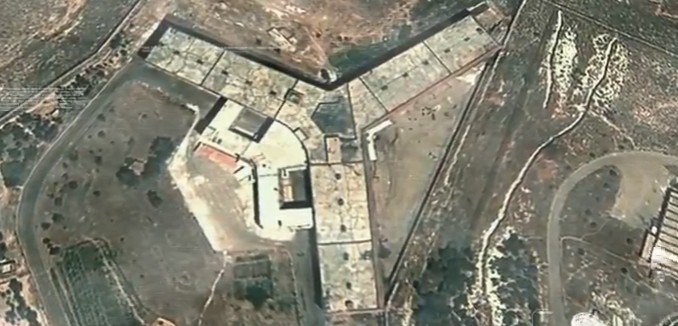Attributing new revelations about the “the depths to which the Syrian regime has gone with the continuing support of its allies, Russia and Iran,” to newly declassified reporting, Acting Assistant Secretary for the Bureau of Near Eastern Affairs Stuart Jones said that the regime had installed a crematorium at a notorious prison north of Damascus to dispose of the bodies of prisoners killed there, in a briefing to reporters Monday.
Acting Assistant Secretary for Near Eastern Affairs Stuart Jones briefs the press on the situation in #Syria. pic.twitter.com/atXOkJp1BG
— Department of State (@StateDept) May 15, 2017
“We now believe the regime has installed a crematorium at the Sednaya prison complex, which could dispose of detainees’ remains with little evidence,” Jones said. “Beginning in 2013, the Syria regime modified a building within the Sednaya complex to support, what we believe, is a crematorium, as shown in the photos we’ve distributed to you.”
Jones explained that while “credible sources have believed that many of the bodies have been disposed in mass graves,” a building in the prison complex had been altered, The Daily Mail reported. A photograph of the building from January 2015 shows it as the lone one in the complex with no snow on its roof.
As many as fifty people a day are estimated to have been hanged at the prison. A February report from Amnesty International called the prison a “slaughterhouse,” in which 13,000 Syrians were killed from 2011 to 2015.
Moreover, Jones called on Russia and Iran, whom he described as Assad’s “closest allies,” to “press for an end to these murderous detention policies.”
Consistent with the Amnesty report, the United Nations formally accused Assad in February 2016 of authorizing the “extermination” of prisoners.
The New Yorker reported in April 2016 on efforts by the Commission for International Justice and Accountability (CIJA) to help establish the culpability of the high-ranking Assad regime officials, who authorize war crimes.
The documentation and testimony being gathered by CIJA has been supplemented by photographs of the regime’s thousands of torture and murder victims, which were smuggled out of Syria by a former military police photographer known as Caesar.
Steven Rapp, then the top war crimes official for the U.S. government, declared in July 2014 that the Caesar’s photographs provided “solid evidence of the kind of machinery of cruel death that we haven’t seen frankly since the Nazis.”
The U.S. House of Representatives overwhelmingly approved a resolution in March 2016 calling for a tribunal to prosecute Assad and his allies for war crimes. The non-binding measure, which passed 392-3, denounced a litany of crimes perpetrated by the Assad regime, including having committed “widespread torture and rape, employed starvation as a weapon of war, and massacred civilians, including through the use of chemical weapons, cluster munitions, and barrel bombs;… [and] subjected nearly one million civilians to devastating sieges and manipulated the delivery of humanitarian aid for its own gain, thereby weaponizing starvation against populations.”
It notably cast blame on the Assad regime, as well as “the Russian Federation, the Islamic Republic of Iran, and Iran’s terrorist proxies including Hezbollah,” for killing the “vast majority” of Syrian civilians who have died in the conflict.
[Photo: laisart company / YouTube ]




